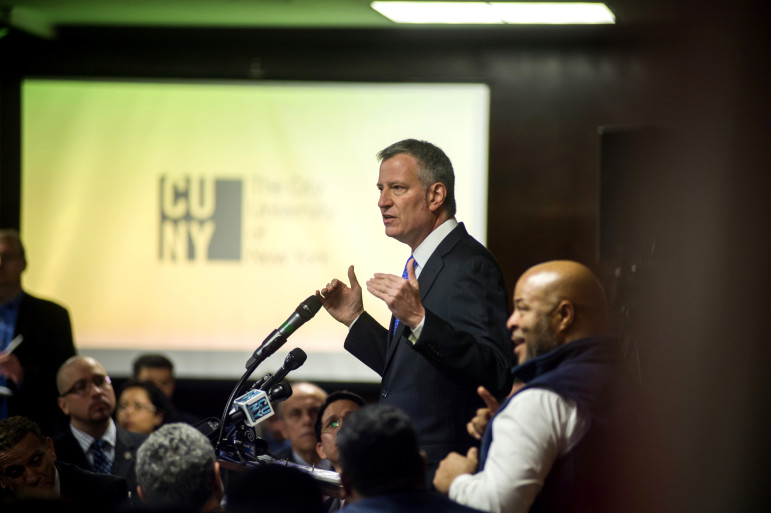
Ed Reed/Mayoral Photography Office
The mayor and his team surmounted skepticism by most community boards, opposition by some unions and doubts from some on the Council to get the landmark changes passed.
In a historic session on Tuesday—with huge but unknown consequences for the city’s future—the City Council voted 42 to 5 to approve Mandatory Inclusionary Housing and 40 to 6, with one abstention, to approve Zoning for Quality and Affordability, giving a green light to key components of the de Blasio administration’s affordable housing plan.
“Mandatory Inclusionary Housing and Zoning for Quality and Affordability is an enormous step forward to making New York City more affordable and more livable for all of its citizens,” said David Greenfield, chair of the Land Use Committee. “We took the mayor’s plan and in consultation with the public, we made it so much better.”
But as councilmembers began casting votes, the balcony erupted with shouts of “City Council vote no, MIH has got to go.” Security staff dragged out five protesters who had bound themselves together to resist removal. While none were arrested, one protester was hospitalized for what city hall staff called “back spasms,” though protesters blamed security staff for the injury.
About 20 minutes later the vote resumed. “There’s palpable anxiety that this plan does not go far enough, is not good enough, and I think those criticisms miss the point,” said Councilman Ritchie Torres, explaining that MIH is supposed to be a floor, not a ceiling, to efforts to generate affordable housing. “Don’t let the perfect be the enemy of the good.”
The passage of these two landmark zoning amendments is undoubtedly an improvement over the status quo. No longer can developers of luxury towers obtain additional density and height while doing nothing to address the city’s affordable housing crisis. Because the city’s current inclusionary housing program is voluntary and limited to specific geographic areas, the city lost the opportunity for an estimated 8,000 affordable units in rezoning areas between 2002 and 2013, according to an analysis by ANHD.
The Council’s revised MIH proposal is also more stringent than the original: As City Limits reported last week, the deal between the Council and the administration creates a new affordability option that requires 20 percent of units for households making 40 percent AMI, or $31,080 for a family of three. It also adjusts the existing options to get more deeply affordable units, requires an additional 5 percent set-aside when the affordable building is located offsite, and ensures that low-income tenants receive equal access to building amenities, among other changes.
But there are reasons to be wary: The policy is far from perfect, and its effect on the city in years to come will depend on the undetermined details of future neighborhood rezonings.
One flaw, raised by Brooklyn Councilmember Jumaane Williams, one of the five dissenting councilmembers, is that MIH doesn’t do enough to prevent economic segregation by neighborhood. Council members will have the power to select from among the four affordability options for projects in their district. Williams worries that higher-income districts will tend to choose options that exclude the lowest-income brackets, while poorer districts will gravitate toward the lower-income options.
“There are some who do not want low-income units in their area and want the option to exclude them to continue,” Williams says.
Second, it’s hard to predict how much the new affordability option will enhance the city’s efforts to reach deeper levels of affordability. The alternative can be paired with one or both of the original options, but cannot be legally required. For instance, City Council can say that the developers of a rezoning neighborhood either set aside 25 percent of the units at 60 percent AMI or 20 percent of the units for households making 40 percent AMI. It is then up to the developer, in consultation with HPD and the local city councilmember, to decide which option to use.
Some housing advocates are worried developers will rarely choose the new option, but city officials said there are situations in which a developer might prefer the alternative because they are required to provide fewer affordable units, though for lower incomes.
Last but not least, while the city can celebrate a new tool in the toolbox, MIH’s impact will depend on how the mayor chooses to wield it. The administration has focused on rezoning low-income neighborhoods like East New York and Jerome Avenue, but some argue that rezoning high-income neighborhoods would be less costly to the city and reduce the threat of displacing residents with an influx of market-rate housing.
It was a concern raised by 40 community organizations that continue to oppose the plan, including 10 of the 65 organizations in the Real Affordability For All Coalition, which officially backed the plan last week.
“The city says it will reach people with lower incomes through HPD subsidies, not Mandatory Inclusionary Housing. But if that is the city’s plan, why is it rezoning and rolling out MIH only in poor communities of color, where the current rents are not high enough to take advantage of MIH?” says a briefing released by the group. “These rezonings and incentives are about the city creating luxury markets in neighborhoods where they don’t currently exist.”









One thought on “Ayes and Nays on Mayor’s Zoning Changes Pave Way for Bigger Questions”
As far I can tell the zoning changes only apply to neighborhoods zoned R6 and up.